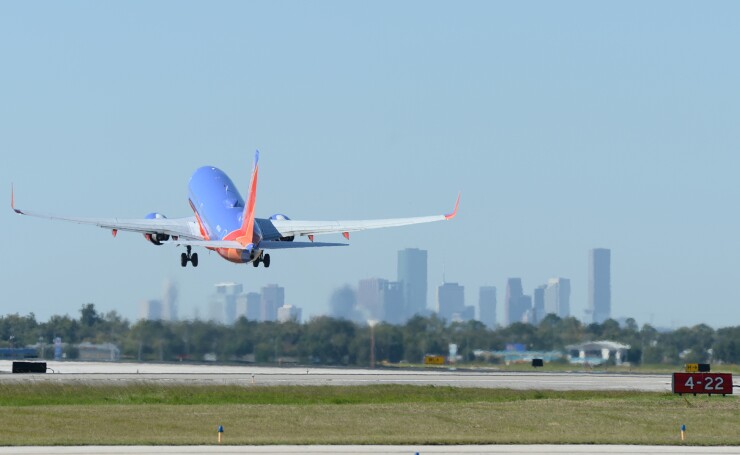A production slowdown at aircraft maker Boeing after problems emerged in its 737 Max line is starting to impact airports, with Southwest Airlines recently announcing it is ending operations at three U.S. locations and cutting service in others.
While the move is not raising immediate credit concerns for affected airports, analysts are keeping an eye on capacity constraints emanating from aircraft shortages as many airports embark on major capital programs.
In its April 25
Houston Airport System
To improve financial performance, Southwest announced it was pulling out of “underperforming markets” at Houston’s George Bush Intercontinental Airport, and airports in Syracuse, New York, and Bellingham, Washington, in early August.
The airline added that significant restructuring will take place in other markets, “most notably by implementing capacity reductions in both Hartsfield-Jackson Atlanta International Airport and Chicago O’Hare International Airport.”
Boeing came under scrutiny in January after one of its 737 Max 9 jets operated by Alaska Airlines lost a door plug while in flight. A subsequent grounding of certain aircraft ordered by the Federal Aviation Administration uncovered more problems, leading the federal agency
The
“Our first quarter results reflect the immediate actions we’ve taken to slow down 737 production to drive improvements in quality,” Boeing President and CEO Dave Calhoun said in a statement. “We will take the time necessary to strengthen our quality and safety management systems and this work will position us for a stronger and more stable future.”
Boeing’s Max manufacturing problems came in the wake of a 20-month grounding of the type in 2019-2020 after poorly designed maneuvering software
Southwest and United Airlines are the carriers most exposed to Boeing, according to analysts. Last month, AP reported that
Southwest is also impacted by delays in Boeing’s planned smaller 737 Max 7 variant, of which it had ordered more than 300. The FAA, amid Boeing’s continued troubles, has yet to certify that version, or the longer Max 10.
“Boeing delivery problems are negatively impacting the ability of airlines to add new flights especially during the peak summer travel season,” Earl Heffintrayer, a Moody’s Ratings analyst, said. “But the impacts for airports are relatively limited.”
He added while aviation has largely recovered to pre-COVID-19 pandemic levels, airlines and airports are below where they would have been had the pandemic not happened.
“In many cases the airports are behind where they needed to be for the growth that already had,” Heffintrayer said. “In some ways the slowing growth allows them to catch up a little bit.”
Capital improvement programs at 20 big U.S. airports or airport systems carry a collective price tag topping $100 billion, according to
Kurt Forsgren, an S&P managing director, said Boeing’s problems won’t affect those plans.
“These plans are firmly focused on where we think things are going to be in five years, and 10 years, and 20 years,” he said.
In the short term, airports affected by Southwest’s pullback could see other airlines stepping in or covering some lost revenue, he noted.
“When someone leaves, (airports) just shift those costs over to other tenants and other airlines, particularly for airfield kind of costs,” Forsgren said. “They might not have that same flexibility for gates, ticket counters, and other facilities that may be vacated by a departing airline although sometimes they could continue to collect revenue over a period of time if they signed a lease.”
A recent Fitch Ratings report said airlines reporting weaker first quarter results “are evaluating their network strategies given the challenges to stay profitable in some markets as elevated costs and aircraft delivery constraints stunt the level of growth they had anticipated. “
“This introduces uncertainty to some U.S. airports aiming to build on their previous progress now that the pandemic rebound is largely considered over,” the report noted, adding that Southwest’s move will not impact the credit profiles of affected airports, including A-plus-rated Houston Airport System.
At Houston’s Bush Airport, where United Airlines is the top carrier, Southwest accounted for only 2.26% of passenger volume, according to the city’s latest aviation data. The airline, which operated at Bush from 1980 to 2005, returned in April 2021. Southwest is the dominant airline at William P. Hobby Airport, where it accounted for about 95% of passengers.
“Houston Airports is now in conversation with other domestic air carriers who want to expand service at Bush Airport, an airport that welcomed record passenger travel in 2023,” Aviation Director Jim Szczesniak said in a statement.
The city is embarking on a $2.55 billion, bond-financed project
In the first quarter, 11.8% of passengers in and out of Syracuse Hancock International Airport
Fitch, which rates the airport A-minus with a stable outlook, said the impact from Southwest’s exit should be modest.
“SYR hit a record 1.3 million enplanements in fiscal 2023 and has a strong financial profile with a relatively small debt burden, negative leverage profile, and a hybrid agreement that provides for sufficient cost recovery,” the rating agency said.
Like Houston, Southwest dominates Chicago’s smaller airport Midway. It started service out of O’Hare, where United and American Airlines are the top carriers, in February 2021. In 2022, Southwest’s share of O’Hare’s enplaned passengers was 2.9%.
At Atlanta’s airport, where Delta Air Lines is the top carrier, Southwest
“ATL values its relationship with all of its airline partners and will continue to work with them to maintain the Airport’s status as a vital hub in the dynamic aviation industry,” the airport said in a statement about Southwest’s capacity reduction there.
